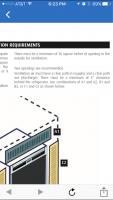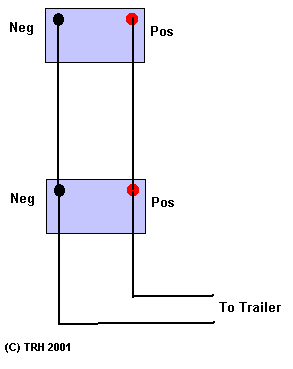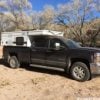Attention a Electrical Sleuths
#81

Posted 07 June 2016 - 11:52 PM
Well, so far nothing has been fixed although I've convinced, myself at least, what's to be done.
FWC has agreed that exterior fridge venting should be in place and committed to installing both upper and lower exterior vents. We are waiting for the vents to be shipped to Oregon where the Tigard distributor will do the installation. Once vents are in, we need to close up and seal off ineffectual interior vent spacing above and below the fridge to mitigate intrusion from dust and insects through the new exterior vents.
My plan here was to use expanded foam board above and below the unit to both close those gaps and increase insulation to the box itsself. I thought I could additionally use foam sheets attached to the unit back not only as additional insulation to the fridge box but as baffling that would serve to channel incoming air through the bottom vent, up and across the compressor, cooling fins, the compressor fan, then out the upper vent. The convection and flow of this air stream is to be assisted by 2-120mm BB fans blowing the heated air out through the upper vent. My thinking is that if all new air is directed past, over and through the cooling mechanism there is no need to cool the lower dead space behind the fridge unit. The two small fans theoretically draw .22 amps each at full speed 1350 rpm. Of course, that's manufacturers specifications when new. Even though they have twin ball bearings I suppose that number will increase over time with wear etc.
I'm not the sharpest tool in the drawer when it comes to refrigeration or electricity for that matter, but I do have a sense for fluid flow and aerodynamics.
The lower part of my 2-way Dometic is just a cooler box. The upper is the mechanism for dissipating heat. Doesn't it make sense to channel all available air past that heated area rather than have it swirling around where it only would serve to warm the area we're trying to cool?
Grandby, I like your idea off a temperature switch. No use running the fans if unnecessary.
Although thinking I'm a smarty pants with the foam baffling...I don't know. I suppose the compressor fan and convection would do the work. After all, any air movement has to go right over and through the only open path. Can you give me some recommendations about a good switch and where I can get one and some additional details about your installation?
I'm all ears if someone wants to chime in here. I've been known to overthink just about everything I come in contact with!
I appreciate every comment, truly!
T
Sent from my iPad using Wander The West
#82

Posted 08 June 2016 - 12:00 AM
about the insulation. I think I'm on the same page. I was thinking of attaching the insulation directly to the box below the cooling fins
I was thinking of the u
Insulation foam from Corning with foil on one side which I thought should face out away from the fridge..reflecting heat?
As per my last post, I'd also shape the foam to direct the incoming air up and across the cooling unit.
Your thoughts?
Ted
#83

Posted 08 June 2016 - 12:16 AM
FWIW I bought this t-stat switch: http://www.amazon.co...lpage_o09_s00 and this t-stat switch: http://www.amazon.co...ailpage_o07_s00 each controlling one of these fans: http://www.amazon.co...ailpage_o08_s00
I think 85° is too low. I need to re-wire them to both work with the adjustable and take the fixed one out.
Edited by ntsqd, 08 June 2016 - 12:16 AM.
Where does that road go?
#84

Posted 08 June 2016 - 01:39 AM
Hi Ted, I didn't add anything more to the back of the fridge as the manual says you need 4 inches minimum behind the fridge of clear space. I would guess that is only needed around the compressor at the top but as it didn't say and I have left a gap around the opening for a bit of flow I thought more at the back would hurt more then help. I remember a post but can't think of it, from someone who added a ton of insulation around the the fridge and the fridge and had issues with the freezer staying frozen. Seemed the temperature sensor is in the fridge and if it doesn't run every so often the freezer won't keep cold. But in any case I for the most part try not to stray to far from the engineers who designed it specs. Once i looked at the manual and got the correct venting and wiring works like a champ. Here is the switched I used. And below it is a screen shot of the manual about the rear of the fridge.Jim,
about the insulation. I think I'm on the same page. I was thinking of attaching the insulation directly to the box below the cooling fins
I was thinking of the u
Insulation foam from Corning with foil on one side which I thought should face out away from the fridge..reflecting heat?
As per my last post, I'd also shape the foam to direct the incoming air up and across the cooling unit.
Your thoughts?
Ted
Let me know if you have any other questions I can help you with. -Neal


1990 Ford F-250
1997 fwc grandby
"Overkill is under rated"
my Grandby upgrades--http://www.wanderthe...-to-me-grandby/
http://www.truckcamp...g-family-earth/
#85

Posted 11 June 2016 - 03:10 PM
I finally found a local RV refrigerator wizard in Portland. An enlightening character who indeed pointed out how I was overthinking everything. He dissuaded me from adding additional insulation around the box and strongly suggested I only add one fan...a slow one at that. He explained that too much air movement can change the pressure and air flow in the small area between the fridge and camper wall to where the natural flows could become confused with turbulence. I suppose like cavitation around the prop of an outboard motor. Monday we're installing both upper and lower vents each with access doors for service, and a single 120mm fan which draws about .2 amps, pushing air out the top vent. We'll see how this works before deciding on a panel size for solar upgrade.
T
Sent from my iPad using Wander The West
#86

Posted 12 June 2016 - 03:30 AM
Sounds right to me, I don't think it takes a whole lot of cfm to exhaust the hot air. Might be interesting if someone had a flir to see the difference.
Craig K6JGV_________________________ 2004 2500 CTD 4X4 FWC HAWK 1960 CJ5
#87

Posted 14 June 2016 - 04:16 AM
Just came across this thread and I have some comments.
First, the standard load test does not tell the right story for deep cycle batteries (unless they are pretty much dead). What you want to know is how many amp-hours are left. As deep cycle batteries age, they provide less and less amp hours. See below for how to test.
Second, the way FWC originally wired two 12V batteries together was incorrect (they have mended their ways). The way your batteries were originally connected resulted in one battery supplying more power than the other. If you started out with two 60 amp hour batteries, after a year of moderate use, one will be reduced to, say, being a 50 amp-hour battery and the other a 40 amp hour battery. This imbalance then ages both batteries even more. The level and frequency that a battery is drawn down determines it's life. Rule of thumb is to stay above 30% draw-down (30 amp hours for a 100 amp hour system). Drawing a deep cycle battery down to 0 (10,6V) greatly shortens its life. The correct way to wire two 12V batteries in parallel is to jumper the two positive terminals together and the two negative terminals together. Then connect your load wires to one terminal on one battery and one terminal on the other battery.
Third, a much better solution to wiring two 12V batteries in parallel is to wire two 6V batteries in series. FWC ought to offer this option instead of dual 12V batteries - they cost out about the same.
Fourth. The Exide batteries that FWC sells are marine batteries - dual starting / deep cycle batteries. Marine type batteries cost less than true deep cycle but they don't last as long. The Concorde Sunsaver batteries are at the top of the list - but pricey. (If price doesn't matter at all, go for lithium ion). The sweet spot for AGM deep cycle batteries are the golf-cart batteries. There's enough volume and competition to make them a good buy (make sure the golf cart batteries are deep cycle AGM - not flooded). Trojan is a well known and reliable brand, but that's not what I'm buying this Thursday (we are retiring our 2005 Eagle and getting a new Fleet on Wednesday). I'm buying a pair of 6V Fullriver batteries (http://www.fullriverbattery.com/main). The people in the battery business that I have talked with and my online research say that Fullriver is as good as or better than the Trojans, at a lower price. Jeff in Tigard sells both Trojan and Fullriver.
Fifth. All deep cycle batteries have a life. A good 100 amp hour battery, treated nicely, can still supply 80 or more amp hours three years later. I suspect that your Exide batteries, given your level of usage, including frequent draw down to 10.9V, your batteries have probably reached end of life..
Finally, I agree with others that the refrigerator cycling is a protection behavior for low voltage. Also, check the seal around the refrigerator door frame. Our Eagle has a Norcolde 3-way, and a service tech once told us that Norcold stopped insulating behind the door frame. When we re-insulated behind the fame, the door didn't open quite as easily - because the refrigerator was more air-tight. I assume Norcold stopped insulation due to complaints, but their solution allowed some cold air to seep out, making the refrigerator less efficient.
To test a deep cycle battery, do the following. Fully charge the battery, run a small load (lights) for a few minutes, and then measure the voltage at the battery. You then connect it to a constant load that draws about 4 or 5 amps - some appliance that operates continuously. You will need to measure the precise current with a clip ammeter or by insrting a shunt on the negative side of the battery and measuring the voltage across it. Current = voltage divided by the shunt resistance. For example, 0.5V across a 100mOhm (0.1 ohm) shunt is 5 amps. Let it run for 4 or 5 hours and then disconnect the load. Keep track of the exact time. Now measure the voltage at the battery. Hours x amps = amp-hours. Assume you ran for 4 hours at 5 amps - you used 20 amp-hours. Now look up a per-cent draw-down chart of an AGM battery (http://caravansplus....attery-size.php). If your battery dropped by 0.2V from 12.8V, then 20 amp-hours is 75% of the battery capacity. Your battery is roughly capable of supplying 100 amp-hours.
A simple digital multimeter (DMM) will give good enough results to know how good your battery is. Harbor Freight gives a DMM away about every 6 months, and $15 to $25 buys a halfway decent one on Amazon (I have a decent Fluke, but I carry the https://www.amazon.c...-3&keywords=DMM because it's much smaller). Everyone should carry a DMM - even if you'r not sure how to use it, you can likely find someone nearby who does and who will help you out.
Edited by Jack, 14 June 2016 - 02:03 PM.
2015 Fleet on 2019 Ranger
#88

Posted 14 June 2016 - 02:32 PM
Than you for the informative post, much of which I have surmised over the last month.
Yesterday we finished adding venting and an additional CPU Fan for the poor refrigerator. Previously their was virtually no venting. The camper has run off the 2-Exide batteries since yesterday morning. That is, the LED lights day during while installing the vents and then with the fridge (Dometic 110) all night.
My Trimetric showed a starting voltage of 13.1v @ 100% charge. This morning it's reading 12.1v @ 84% charge and my fridge is again cycling although not drawing as much amperage as it had been before the venting. It was cold last night so the fridge did not have to work hard. Regardless of the numbers, I believe the batteries too are damaged. Likely aided by the faulty wiring from the factory and insufficient cooling from the lack of venting for the fridge compressor. Their is no question that heated air is now exhausting from the upper vent!
Your right about the weatherstripping on the fridge door. Twice I've found it hanging at the bottom where of course the seal was faulty. I check it regularly now. Thankfully the fridge runs fine on 110 so I don't think it's damaged....yet.
Lastly, my Trimetric history suggests the batteries have not been getting a full charge during the day; even if driving for several hours in full sun. From what I read, the alternator is providing little more than a trickle charge and the single 90-95 watt panel is insufficient for the large fridge.
No wonder. It's taken two years to finally get a handle on this system and equally irritating that we pay $$$ to learn this stuff from hard knocks.
Today I'm buying two Full River 224-6v AGM batteries but need to make room for them in the cabin. We are heading out for a couple of weeks so I'll have to find supplemental110 charging so as not to run the new batteries down too far before upgrading the solar power.
Oops, I almost forgot, as a test, I ran the batteries low, individually. The second battery (originally jumped by the faulty factory setup), ran down faster than the main battery which always received a full proper charge.
Sent from my iPad using Wander The West
#89

Posted 14 June 2016 - 02:58 PM
Please post a diagram of the faulty wiring of the batteries. I assume the load and charge wiring was to just one of the two batteries and not across both.
Correct way

Wrong way

Edited by billharr, 14 June 2016 - 02:59 PM.
Bill Harr 2005 Tundra and a 2013 Hawk custom interior.
#90

Posted 14 June 2016 - 03:26 PM
I'm not sure there is any difference in how those two batteries are being wired in the previous picture.
They are both the usual parallel way used for two 12 volts together.
2015 Silverado Crew Cab Duramax and 2015 Front Dinette Grandby
One can change the world, it only requires kindness
http://www.truckcamp...g-family-earth/
0 user(s) are reading this topic
0 members, 0 guests, 0 anonymous users


















